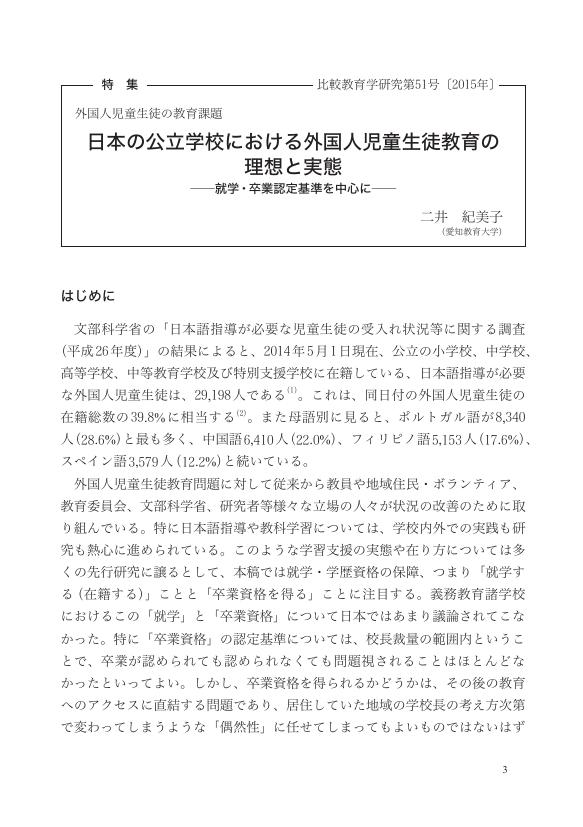1 0 0 0 OA アメリカにおけるキャラクター・エデュケーションの動向 特集 子どもの危機と教育の対応
- 著者
- 岩佐 信道
- 出版者
- 日本比較教育学会
- 雑誌
- 比較教育学研究 (ISSN:09166785)
- 巻号頁・発行日
- vol.2000, no.26, pp.18-28, 2000-07-05 (Released:2011-01-27)
- 参考文献数
- 22
- 著者
- 米澤 彰純
- 出版者
- 日本比較教育学会
- 雑誌
- 比較教育学研究 (ISSN:09166785)
- 巻号頁・発行日
- vol.2014, no.48, pp.156, 2014
- 著者
- 小松 太郎
- 出版者
- 日本比較教育学会
- 雑誌
- 比較教育学研究 (ISSN:09166785)
- 巻号頁・発行日
- vol.2017, no.55, pp.59-71, 2017
1 0 0 0 渡辺雅子著「納得の構造-日米初等教育に見る思考表現のスタイル-」
- 著者
- 恒吉 僚子
- 出版者
- 日本比較教育学会
- 雑誌
- 比較教育学研究 (ISSN:09166785)
- 巻号頁・発行日
- vol.2005, no.31, pp.281-283, 2005
- 著者
- タスタンベコワ クアニシ
- 出版者
- 日本比較教育学会
- 雑誌
- 比較教育学研究 (ISSN:09166785)
- 巻号頁・発行日
- vol.2007, no.35, pp.33-48, 2007-06-25 (Released:2011-01-27)
- 被引用文献数
- 1
1 0 0 0 OA 日本の公立学校における外国人児童生徒教育の理想と実態 ―就学・卒業認定基準を中心に―
- 著者
- 二井 紀美子
- 出版者
- 日本比較教育学会
- 雑誌
- 比較教育学研究 (ISSN:09166785)
- 巻号頁・発行日
- vol.2015, no.51, pp.3-14, 2015 (Released:2020-08-15)
1 0 0 0 フランス多民族国家における「統合」社会像の矛盾
- 著者
- 池田 賢一
- 出版者
- 日本比較教育学会
- 雑誌
- 比較教育学研究 (ISSN:09166785)
- 巻号頁・発行日
- vol.1998, no.24, pp.86-100, 1998
In France the educational policy for children of immigrants and foreigners began to be formed in the 1970s.That was aimed to adapt them to French society and school through their learning French.In the 1980s the policy for ‘right to be different’ attracted an attention of the public in the dominant political power of the Socialist Party.But for many foreign children born in France the policy of ‘adaptation’ and ‘admitting difference’ is not necessarily relevant.Presently the policy of ‘integration’ is being adopted to make the French society through participation and solidality of all people.
- 著者
- 江原 裕美
- 出版者
- 日本比較教育学会
- 雑誌
- 比較教育学研究 (ISSN:09166785)
- 巻号頁・発行日
- vol.2007, no.35, pp.65-83, 2007-06-25 (Released:2011-01-27)
1 0 0 0 OA 1988年イギリス教育改革法の主要点と問題点
- 著者
- 宮腰 英一
- 出版者
- 日本比較教育学会
- 雑誌
- 比較教育学研究 (ISSN:09166785)
- 巻号頁・発行日
- vol.2002, no.28, pp.28-40, 2002-06-30 (Released:2011-01-27)
1 0 0 0 OA 中国における二言語教育と民族的アイデンティティの形成 民族文化共生の視点から
- 著者
- 張 瓊華
- 出版者
- 日本比較教育学会
- 雑誌
- 比較教育学研究 (ISSN:09166785)
- 巻号頁・発行日
- vol.1998, no.24, pp.180-197, 1998-06-30 (Released:2011-01-27)
Bilingual education has been adopted in school education in order to carry outan equality policy for ethnic groups in China. There are two modes of bilingualeducation in China. One is using the ethnic language as a teaching language while Chinese is taught as a subject. The other is where Chinese is used as a teachinglanguage and the ethnic language is taught as a subject. Bilingual education has beenregarded as useful in promoting a common language and forming common culture, andalso helpful in maintaining ethnic language and culture. Does it really have such a keyrole? It is very interesting to study the function of bilingual education in formation ofethnic identities in China from the perspective of coexistence of multiethnic cultures.
1 0 0 0 外国人児童生徒の教育を考える:試される日本の学校
- 著者
- 馬越 徹
- 出版者
- 日本比較教育学会
- 雑誌
- 比較教育学研究 (ISSN:09166785)
- 巻号頁・発行日
- vol.1994, no.20, pp.189-193, 1994
1 0 0 0 OA 丸山英樹・太田美幸編著『ノンフォーマル教育―リアルな生活に根ざす教育へ―』
- 著者
- 丸山 英樹
- 出版者
- 日本比較教育学会
- 雑誌
- 比較教育学研究 (ISSN:09166785)
- 巻号頁・発行日
- vol.2014, no.49, pp.213, 2014 (Released:2020-05-01)
1 0 0 0 OA ドイツにおける学校週5日制
- 著者
- 長島 啓記
- 出版者
- 日本比較教育学会
- 雑誌
- 比較教育学研究 (ISSN:09166785)
- 巻号頁・発行日
- vol.1997, no.23, pp.5-14, 1997-05-30 (Released:2011-01-27)
- 著者
- 中室 牧子 山崎 泉
- 出版者
- 日本比較教育学会
- 雑誌
- 比較教育学研究 = Comparative education : bulletin of the Japan Comparative Education Society (ISSN:09166785)
- 巻号頁・発行日
- no.44, pp.88-108, 2012
1 0 0 0 マリオンM. スコットと日本の教育
- 著者
- 古賀 徹
- 出版者
- 日本比較教育学会
- 雑誌
- 比較教育学研究 (ISSN:09166785)
- 巻号頁・発行日
- vol.1991, no.17, pp.43-56, 1991
- 被引用文献数
- 1
1 0 0 0 OA アメリカにおけるホームスクール運動の成長と変容
- 著者
- 長嶺 宏作
- 出版者
- 日本比較教育学会
- 雑誌
- 比較教育学研究 (ISSN:09166785)
- 巻号頁・発行日
- vol.2003, no.29, pp.114-132, 2003-06-27 (Released:2011-01-27)
This paper considers the characteristics of the home schooling movement which rose to prominence in the United States during the 1980s. Home schooling consists of instruction and learning conducted in a family setting in place of attending at school. The numbers of ‘home schoolers’ have been increasing rapidly in recent years, and according to an estimate by P. M. Lines they have reached a total of between 1.5 million and 2million.The growth of home schooling may be explained in terms of two separate movements, both educational and social. Viewed in social terms encompassing political, cultural, and religious elements, it may be thought of as having received strong influences from the new conservatism and the new religious right. The new religious right became a powerful voice in the United States during the 1980s, and this was reflected in the development of home schooling at the time. On the other hand, home schooling also grew as part of an educational movement organized by people who sought an alternative to public education. Criticism of public education had become widespread since the 1960s, and education at home was seen as a means of avoiding exposure to a discredited system.
1 0 0 0 OA イギリスにおけるイスラム教徒の学校教育に関する一考察 -多文化教育の実現に向けて-
- 著者
- 古賀 毅
- 出版者
- 日本比較教育学会
- 雑誌
- 比較教育学研究 (ISSN:09166785)
- 巻号頁・発行日
- vol.2008, no.37, pp.26-35, 2008-06-25 (Released:2011-01-27)
1 0 0 0 OA 茅島篤著国字ローマ字化の研究
- 著者
- 三輪 建二
- 出版者
- 日本比較教育学会
- 雑誌
- 比較教育学研究 (ISSN:09166785)
- 巻号頁・発行日
- vol.2001, no.27, pp.230-231, 2001-06-22 (Released:2011-01-27)









